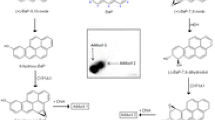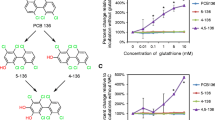Abstract
Hexachloro-1,3-butadiene (HCBD) is more nephrotoxic to female than male rats. Metabolism of HCBD involves conjugation with glutathione followed by formation of the cysteine conjugate S-(pentachloro-1,3-butadienyl) cysteine (PCBD-CYS) and then the mercapturic acid N-acetyl-S-pentachloro-1,3-butadienyl-cysteine (PCBD-NAC). PCBD-NAC is also more nephrotoxic to female rats than male rats. The deacetylation of [14C]-PCBD-NAC to PCBD-CYS and the binding of radiolabelled metabolites to protein has been studied using renal cytosol preparations from male and female rats in vitro, since a sex-related difference in these reactions could explain the difference in nephrotoxicity found in vivo. PCBD-NAC was rapidly metabolised by renal cytosol. The rate of metabolism was similar with either male or female renal cytosol, and the major metabolite identified was PCBD-CYS. N-Acetylation of PCBD-CYS to PCBD-NAC was not detected in the presence of either male or female renal cytosol. Covalent binding of radioactivity from [14C]-PCBD-NAC to cytosolic protein could be detected after 5 min incubation, and although the extent of binding was similar for both male and female cytosol at early time periods, after 60 min incubation more binding was found in the presence of male cytosol. Covalent binding was largely prevented by aminooxyacetic acid, an inhibitor of cysteine conjugate β-lyase, suggesting a role for this enzyme in the activation of HCBD. These results indicate that the sex differences in the nephrotoxicity of HCBD and PCBD-NAC in the rat are not attributable to differences in the rate of deacetylation of PCBD-NAC to give the proximate nephrotoxin PCBD-CYS.
Similar content being viewed by others
References
Berndt WO, Mehendale HM (1979) Effects of hexachlorobutadiene (HCBD) on renal function and renal organic ion transport in the rat. Toxicology 14: 55–65
Davis ME, Berndt WO, Mehendale HM (1980) Disposition and nephrotoxicity of hexachloro-1,3-butadiene. Toxicology 16: 179–191
Elfarra AA, Jakobsen I, Anders MW (1986) Mechanism of S-(1,2-dichlorovinyl) glutathione-induced nephrotoxicity. Biochem Pharmacol 35: 283–288
Gradiski D, Duprat P, Magadur JL, Fayein E (1975) Etude toxicologique experimentale de l'hexachlorobutadiene. Eur J Toxicol 8: 180–187
Green T, Odum J (1985) Structure/activity studies of the nephrotoxic and mutagenic action of cysteine conjugates of chloroand fluoroalkenes. Chem Biol Interact 54: 15–31
Harleman JH, Seinen W (1979) Short term toxicity and reproduction studies in rats with hexachloro-(1,3)-butadiene. Toxicol Appl Pharmacol 47: 1–14
Hook JB, Ishmael J, Lock EA (1983) Nephrotoxicity of hexachloro-1,3-butadiene in the rat: the effect of age, sex and strain. Toxicol Appl Pharmacol 67: 122–131
Ishmael J, Lock EA (1986) Nephrotoxicity of hexachlorobutadiene and its glutathione-derived conjugates. Toxicol Pathol 14: 258–262
Ishmael J, Pratt IS, Lock EA (1982) Necrosis of the pars recta (S3 segment) of the rat kidney produced by hexachloro-1,3-butadiene. J Pathol 138: 99–113
Kociba RJ, Keyes DG, Jersey GC, Ballard JJ, Dittenber DA, Quast JF, Wade CE, Humiston CG, Schweiz BA (1977) Results of a two-year chronic toxicity study with hexachlorobutadiene in rats. Am Ind Hyg Assoc J 38: 589–602
Lock EA, Ishmael J (1985) Effect of the organic acid transport inhibitor probenecid on renal cortical uptake and proximal tubular toxicity of hexachloro-1,3-butadiene and its conjugates. Toxicol Appl Pharmacol 81: 31–42
Lock EA, Ishmael J, Hook JB (1984) Nephrotoxicity of hexachloro-1∶3-butadiene in the mouse: the effect of age, sex and strain. Toxicol Appl Pharmacol 72: 484–494
Lock EA, Odum J, Ormond P (1986) Transport of N-acetyl-S-pentachloro-1,3-butadienylcysteine by rat renal cortex. Arch Toxicol 59: 12–15
Lowry OH, Rosebrough NJ, Farr AL, Randall RJ (1951) Protein measurements with the Folin phenol reagent. J Biol Chem 193: 265–275
Nash JA, King LJ, Lock EA, Green T (1984) The metabolism and disposition of hexachloro-1,3-butadiene in the rat and its relevance to nephrotoxicity. Toxicol Appl Pharmacol 73: 124–137
Odum J, Green T (1984) The metabolism and nephrotoxicity of tetrafluoroethylene in the rat. Toxicol Appl Pharmacol 76: 306–318
Reichert D, Schütz S (1986) Mercapturic acid formation is an activation and intermediary step in the metabolism of hexachlorobutadiene. Biochem Pharmacol 35: 1271–1275
Reichert D, Schütz S, Metzler M (1985) Excretion pattern and metabolism of hexachlorobutadiene in rats: evidence for metabolic activation by conjugation reactions. Biochem Pharmacol 34: 499–505
Wolf CR, Berry PN, Nash JA, Green T, Lock EA (1984) Role of microsomal and cytosolic glutathione-S-transferases in the conjugation of hexachloro-1,3-butadiene and its possible relevance to toxicity. J Pharmacol Exp Ther 228: 202–208
Author information
Authors and Affiliations
Additional information
This work was supported by a fellowship from the European Science Foundation granted to I. S. P.
Rights and permissions
About this article
Cite this article
Pratt, I.S., Lock, E.A. Deacetylation and further metabolism of the mercapturic acid of hexachloro-1,3-butadiene by rat kidney cytosol in vitro. Arch Toxicol 62, 341–345 (1988). https://doi.org/10.1007/BF00293620
Received:
Accepted:
Issue Date:
DOI: https://doi.org/10.1007/BF00293620




